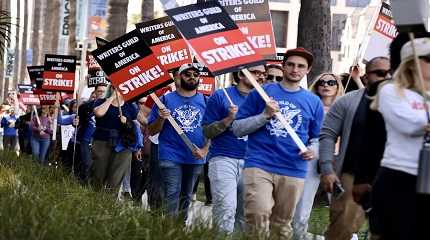
LOS ANGELES, July 24 (Xinhua) -- In recent weeks, the United States has experienced an unprecedented surge in union activities and strikes, as workers across multiple industries take matters into their own hands. Existing labor concerns combined with the economic aftermath of the COVID-19 pandemic has sparked a tsunami of industrial action not seen in decades.
Hollywood actors and screenwriters, hotel workers, postal workers, automakers, and others are either actively on strike or poised to initiate action, making the current nationwide heatwave even hotter as sparks fly.
The early headline-grabbers were the Screen Actors Guild-American Federation of Television and Radio Artists (SAG-AFTRA) representing about 160,000 actors and workers in television and film and the Writers Guild of America (WGA) representing about 11,500 screen writers entering their second combined week.
They are protesting over pay, healthcare benefits, and protection from the encroachment of artificial intelligence on human creative spheres and have already seriously disrupted TV and film production across the United States.
Also threatening to bring down the curtain on the entertainment industry are the International Alliance of Theatrical Stage Employees (IATSE). IATSE and the Broadway League narrowly avoided shutting down iconic Broadway theaters by reaching a tentative agreement on a "pink contract" last Thursday and averting a potential strike that could have shuttered theaters and tours nationwide.
Their agreement, still pending ratification by the approximately 1,500 IATSE members it covers, seeks to maintain employer-provided healthcare, secure employer-provided housing for touring crews and to address the desire for increased wages and rest periods.
But those examples of labor unrest are just the tip of a rapidly melting iceberg in what analysts call the "Hot Summer of Labor." Many normally toothless unions are biting back against what they call "fat cat" executives who are milking company coffers for bloated executive salaries while short-changing the "little guys" on the workforce who keep the wheels of industry turning.
In Southern California, thousands of hotel workers, represented by UNITE HERE Local 11, have also gone on strike. Described as the largest multi-hotel strike in California history, the action is part of the workers push for better pay and improved benefits.
Their strike is not only about higher wages, it's about enabling the workers to afford to live closer to their workplaces - no small feat in a city like Los Angeles where skyrocketing rents have forced ordinary workers further and further out into distant districts, where they must spend hours each day commuting to and from work.
Though an agreement has been reached with Western Bonaventure hotel, 59 other hotels have yet to agree on a new contract affecting nearly 15,000 hotel workers. This has led to workers pulling up the welcome mat on hotel businesses and scheduled events.
This workers' strike action included walkouts during the booming Fourth of July weekend - one of the largest weekend's for the U.S. tourism industry - and has already forced groups like the Democratic Governors Association to decamped to other venues.
Another potentially crippling strike about to be delivered is United Parcel Service (UPS), which might mean all packages will soon be marked "return to sender." UPS is currently locked in negotiations with the Teamsters union regarding wage disputes, especially for experienced part-time workers.
Without a new contract, approximately 300,000 Teamsters will hit the road on Aug. 1, in their first massive union action in approximately 25 years. And if UPS workers strike, it won't just be shopaholic consumers who end up empty-handed.
UPS handles almost 25 percent of U.S. package deliveries, so a strike there would have devastating consequences across multiple industries and supply chains, including medical supplies, parts for the automotive, computer and electronic industries, retail outlets for clothing, shoes, accessories and more.
Financial analysts with the Anderson Economic Group estimates that a 10-day UPS strike could be the most expensive strike in the country's history - costing in the U.S. economy approximately 7 billion U.S. dollars.
And the list goes on as labor develops new muscle and is striking back with a vengeance. A potential strike is revving up in the automotive industry as union leaders put the pedal to the medal. United Auto Workers (UAW), which represents 150,000 hourly workers at General Motors, Ford and Stellantis are gearing up for a possible strike action as contracts are set to expire in September.
UAW President Shawn Fain has criticized the auto giants record profits and their attempts to move manufacturing abroad as having an unfair impact on U.S. workers. Automakers contend that they already offer competitive wages and benefits, and say they need to remain competitive as they invest in next generation electric vehicles.
Not to be left in the wings, Southwest Airlines pilots are also considering coming in for landing - and staying there - if their negotiations with the aeronautical industry break down. And medical firms and hospitals may also have to take their medicine if 85,000 Kaiser Permanente workers succumb to the "blue flu" later this year.
These strikes, and the potential for more, represent a significant resurgence in union activity in the country. While they could lead to disruptions in various sectors, many view this development as a turning point for labor to retake the power they've lost, starting with the anti-labor era of former U.S. President Ronald Reagan. With activism running high, unions see the potential to boost their membership, which had seen a steep decline from about 20 percent of the private sector in the early 1980s to just 6 percent now.
The outcomes of these action could set a precedent and inspire other workers to follow suit as labor experiences a new call to arms across the country.




